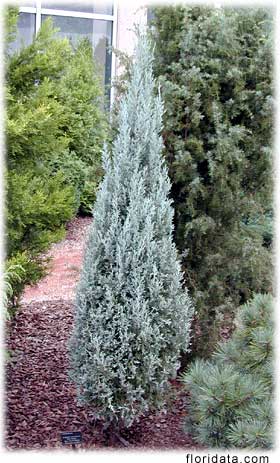Rocky Mountain Juniper Tree Seeds
Find your zone using Garden Web's Zone Finder

Photo and cultural info courtesy of Floridata.com
D7880
Rocky Mountain Junifer Juniperus scopulorun Rocky Mountain juniper is an evergreen large shrub or small tree to 50' tall, but usually much smaller. Specimens are variable in habit, sometimes squat and shrubby, but usually narrowly cone shaped. The trunk is short and stout, often dividing near the ground. The branches are rather thick and spreading to partly erect. Rocky Mountain juniper has reddish bark that is stringy in narrow strips but does not exfoliate. Most of the leaves are like overlapping scales, closely pressed to the twigs. Juvenile leaves, usually only found on young seedlings, are more like needles, and they spread away from the twigs. The foliage is dense and pleasantly aromatic.
Trees may have male or female cones, but not both. The fruits are fleshy berrylike spherical cones, about one-third inch in diameter. They are bright blue with a whitish bloom and sweet tasting, with thin skins. Rocky Mountain juniper is closely related and quite similar to eastern redcedar, and was once believed to be the same species. But eastern redcedar has fruits that mature in a single season, whereas those of Rocky Mountain juniper take two year to ripen. Also, eastern redcedar had exfoliating bark. The two species hybridize where their ranges overlap.
Location: Rocky Mountain juniper occurs in isolated and scattered localities within a wide band from British Columbia to North Dakota, and south to Arizona and New Mexico. It grows from near sea level in the northern part of its range to more than 8000' above sea level in the south. Rocky Mountain juniper grows in alkaline soils on ridges, cliffs and rocky slopes, sometimes in pure stands, but more often in association with other mountain loving evergreens such as ponderosa pine, pinyon pine and Douglas-fir.
Culture: Rocky Mountain juniper is a slow growing tree
(6-12" per year), but one that can live more than 300 years. In
cultivation it tolerates acidic to alkaline soils, and does
best in those that are loose and well drained. It is best
adapted to culture in western and northern North America.
Light: Seedlings and saplings can tolerate rather dense shade,
but Rocky Mountain junipers, even the smaller cultivars, need
full sun to grow to their full potentials.
Moisture: Rocky Mountain juniper is tolerant of drought, but
perhaps less so than the other junipers. It should be watered
before the soil becomes completely dry. This juniper does
poorly in humid climates, but does fine in hot, dry
climates.
Hardiness: USDA Zones 4 - 7.
Usage: Use any of the cultivars of Rocky Mountain juniper for
attractive foliage effects in all seasons. This evergreen is
useful as a screen, hedge or foundation plant. They make great
anchors or focal points for the ends of hedges or mixed
borders. Rocky Mountain juniper is a tidy, formal accent shrub
alone or in small groups.
Features: Although most cultivars are probably too formal for
naturalistic gardens, Rocky Mountain juniper is ideal for neat,
well-organized landscapes. Most cultivars require little or no
pruning and are relatively free of cultural problems, insects
and diseases. They tolerate heat and drought well.

